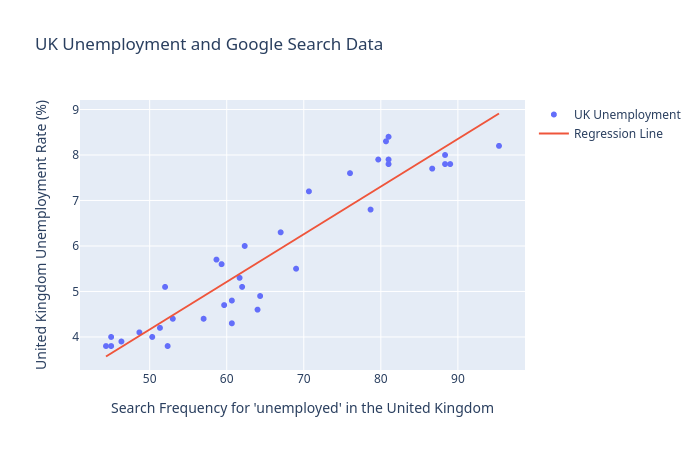Predicting Unemployment Using Google Search Data
On the 7th of May, the Bank of England released their quarterly Monetary Policy Report in which they detail the current state of the economy and what it could be like in the near future. While reading through it, I found one section particularly interesting. In the report, the BoE writes
As business output surveys are providing a less useful steer than usual, Bank staff are using a wider range of indicators to gauge how GDP is likely to evolve. These include new weekly surveys of businesses and households and high-frequency spending data. Using all of these sources, Bank staff estimate that monthly GDP will fall by enough in March to pull GDP down by around 3% in Q1 as a whole.
As a result of the speed at which the circumstances are changing, conventional measures are becoming less useful so they’ve resorted to other alternative indicators to gauge economic activity. One example that caught my eye was the inclusion of google search data in the report which in fact inspired me to do my own small bit of research.

To begin, I went on google trends and collected search data from January 2011 up to the present month for the word “unemployed”. After doing this, I collected unemployment data from the ONS. Once I had collected the data, I had to re-organise it a bit since the search data was monthly and the unemployment data was quarterly. However, I was able to easily resolve this by grouping the search data by the quarter they appeared in and then taking a mean. Once I had done all this I then performed basic linear regression on the data to get a function from the google search data to an estimate for unemployment which turned out to perform quite decently.

Since I now have this function, I can apply it to other data. I took the search data for the months in Q1, took a mean and put it through the function to get an estimate of 5.42% unemployment for Q1 and 8.35% unemployment for Q2 with a calculated margin of error of 0.89%. However, the Q2 prediction isn’t as reliable since Q2 hasn’t ended yet and the search data is incomplete. Not only this but the true figure for Q2 unemployment will only be released in August, which is 3 months away!
Even though the first quarter has already ended, the ONS unemployment data associated with it will only be released on the 19th of May which is 3 days away at the time of writing. As a result of this, I decided to make a prediction and wait to see how close or far-off it was from the true results. I originally made my predictions on the 8th of May but I ended up postponing the write-up for quite a while.
I’ll get to see how well my predictions hold up soon, but I can compare my results with those of other organisations in the meantime. The BoE reports a figure of 9% unemployment for Q2 which is within the margin of error for my Q2 prediction even though the search-data hasn’t completely materialised yet. Using unemployment data up to february, the BoE also forcasts an unemployment figure of 4.6% for the first quarter. Which is also within the margin of error of my own prediction.
If these forecasts are indeed accurate then this paints a very scary picture for the economy, the people inside it and the near future of the country.